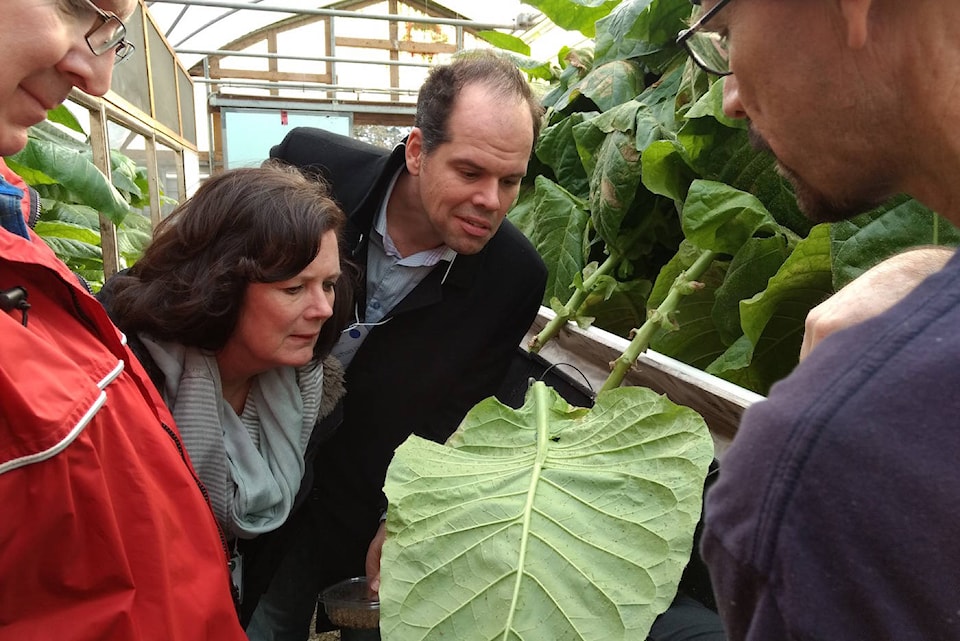The Saanich Peninsula is home to many businesses, some well-known, others less so. They all contribute to the local economy, so the Saanich Peninsula Chamber of Commerce featured both in their annual Tour of Industry, which happened on Friday, January 26.
This is the third in a series.
Inside PhilbrookB��Ԫ������ַ�s Boatyard, narrow hallways twist and turn in unusual ways. A conspicuous V-shaped wall juts out to accommodate the bow of a 130-foot yacht, which required carpenters to fit the facility around the boat.
For over two and a half years, the yard has been working on a total refit of the boat, first built in 1997. PhilbrookB��Ԫ������ַ�s workers have extended the yacht by 10 feet, upgraded the kitchen with commercial appliances, added all-new plumbing and electrical and much more.
Jamie Hansen, the project manager for the yacht, did not say exactly how much the refit cost, but he said if purchased new, the boat would be around $27 million.
The project is slated for completion by the end of April, but there are about a dozen vessels outside the boatyard, all waiting to be cleaned or maintained, with a dozen more yet to come.
Founded in 1955, PhilbrookB��Ԫ������ַ�s is a full-service facility. They do everything in-house, including mechanical, electrical, painting, woodworking, detailing, metal fabrication, canvas, and upholstery.
Drew Irwin, the co-owner and CEO, said the company has found very talented workers in the last year, but they are still looking to add to their current staff of 75. On the tour, project manager Hansen pointed to a B��Ԫ������ַ�Help WantedB��Ԫ������ַ� banner outside, which he said has been there for years.
Irwin said they have enough woodworkers, but he is looking for basically every other position, from boat washers, receptionists and accountants, to electricians, canvas and upholstery workers.
Irwin said they have looked at a bigger facility in the past, but they are constrained by their building. They have fabricated parts for 300-foot-long vessels, but if servicing a whole vessel, they are limited to about 130 feet.
B��Ԫ������ַ�IB��Ԫ������ַ�d love to get access to a 200-footer in the building, or at least a 150, and then access on the dock, too.B��Ԫ������ַ�
High Peninsula home prices are also a challenge. Irwin said a lot of his staff, who he says B��Ԫ������ַ�are paid pretty well,B��Ԫ������ַ� live in Langford and commute out because many prefer single-family homes, which are out of their price range.
However, Irwin likes the location because boaters often stop here from Anacortes, Seattle, or California. He is happy the Town of Sidney has been accommodating, approving a height variance on their building. They just bought some property on Harbour Road with dock space and some workshop areas, and they are not sure what to do with it just yet.
B��Ԫ������ַ�Our key is flexibility, itB��Ԫ������ַ�s catering all our facilities to fit a bunch of 40-foot boats, or one large boat.B��Ԫ������ַ�
Bio pest control
Compared to PhilbrookB��Ԫ������ַ�s, Applied Bio-nomics is quite a bit more humid. They produce biological pest controls B��Ԫ������ַ� natural predators as an alternative to pesticides. The company was founded in 1981 at the Saanichton Research Farm. In 1985 they moved to North Saanich.
Brian Spencer, president of Applied Bio-nomics, showed groups their chemical-free approach to controlling a variety of pests. Spencer said a key part of cultivating these predators was actually growing the pests. After all, the predators need food to grow.
He explained it was a B��Ԫ������ַ�tritrophic process,B��Ԫ������ַ� where they grow a plant, then the pest, then the predator. The plant feeds the pest, and the pest feeds the predator.
Warren Bond showed the group how the company grows Aphidoletes aphidimyza, a midge (small fly) they call an B��Ԫ������ַ�aphid eliminator.B��Ԫ������ַ�
First, they grow tobacco plants, which are sacrificial. Tobacco was chosen for its speed, growing from the size of poppy seeds to full sized plants in two months, as well as its large leaves, which provide lots of surface area for the aphids and their predators. Aphids on the underside of the leaves are eaten by the Aphidoletes aphidimyza during the larvae stage. When they become pupae, they fall off the plant and into a water collection system where they are then packaged and sold. The tobacco leaves, yellow and drooping after the process is complete, are then composted.
Bond said unlike ladybugs (another kind of biological pest control), the Aphidoletes aphidimyza do not fly quite as far, so they can be applied in a targeted fashion. In addition, these are native to the area, whereas many ladybugs are actually from California.
Their product is used by Butchart Gardens, Eurosa Farms, Longview Farms, Sun Wing, and DanB��Ԫ������ַ�s Farm. They are also sold in smaller packages to keen home gardeners at Russell Nursery.
Read on next week for the final instalment, about Nicholson Manufacturing and the challenges of the trades industry.



